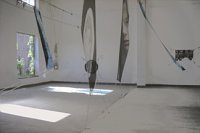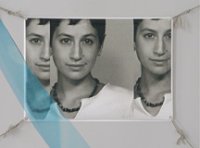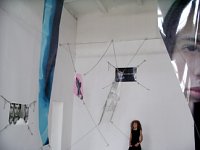Volume 29, No. 4, Dec 2006
Self-Devolution: Barbara Rosenthal in Japan and China
In June of 2006, I accepted a residency at the Red Gate Gallery, Beijing, directed by Brian Wallace, who arranged an installation, “Self-Devolution,” at Pickled Art Centre. In May, I left NY so that on the way I could make a 10- day stopover in Japan to see some of the coast and visit Ryousuke Cohen in Osaka.

I spent four misty days in Juyo Hotel, in a tiny tatami-matted room in Taito-Ku, Tokyo, walking my camera and journal on 14-hour visits to Buddhist shrines, old neighborhoods, the Ginza, Bunraku Puppets and Kabuki Theater. Sushi, which in NY is good, in Tokyo is fantastic – much smoother and fleshier. The hedonism of the country, with its beautiful, simple, insistent design, and raw, fresh food, appeals to me. I had brought 50 rolls of 35mm film, mostly B&W, which is best for my surreal imagery, shot with an Olympus OM-1 and 35mm lens, and for color and travel memories, a tiny Canon mini-DV. Digital cameras, still and video, are in the hands of most of the residents and local tourists at the shrines, so I wasn’t embarrassed to take pix at religious sites, but it was difficult to maintain the trance state I need to shoot surreal photos. The contacts I’ve processed by now show me that the percentage of such shots is greater while I was on the fast trains, shooting from windows, and while walking at night.
The train next took me to the strange, black, smoking, sulfurous volcanic mountains around Hakona, before I went on to spend the next four days at the Kyoto Youth Hostel, with its private garden, hot tub and communal meals, within walking distance to many shrines and neighborhoods much older than those of Tokyo. Next I rolled on to Osaka to see Ryousuke.

I’d written to him to say I could go through Japan on the way to Beijing, if he’d like. We’d never met in person, but wanted to because our names have been showing up together on lists of participants in Mail Art shows for about 30 years. He and his friends met me in the Osaka Castle Park, and took me to the modernistic apartment of Shingo, who hosted me for several days. In one of the most gratifying-satisfying-flattering-incredible experiences of my life, when we arrived at Shingo’s apartment, I saw that they had downloaded all the numerous catalogs and writings from my website and translated dozens of pages into Japanese. It is one thing to meet or know an artist in person, and many artists do know each other, but to put so much effort into really knowing the work that an artist has produced, speaks of the real reason anyone would want to know another artist at all, and I was grateful and impressed that they had gone to so much effort. As I’d done much the same thing in NY before even contacting Ryousuke, it made me more at ease than I would have been otherwise. Interpersonal relationships are not my forte, and it is better for me if someone meets me as the flesh-being that’s created certain work, than as a real person. Needless to say, their hosting was sensational, including nightsful of sake and sushi, and days at an elegant spa – ah those pleasure-finding Japanese. I plan to do them up well in NY in 2007, and have been everywhere promoting Mr. Cohen’s idea of “copy left,” which is the open use by other artists of all visual imagery as if it were landscape.

As for my Red Gate Gallery residency in Beijing, I refer you to the article in the Nov-Dec 06 NYArts Magazine which will take you from my arrival in China through the production phase of my irregularly-shaped suspended and roped transparent print installation at Pickled Art Centre, in the issue of Nov-Dec 2006, also on the web here. I can skip that phase here, and take you directly to the show itself (see images accompanying this Umbrella article), which brought with it the interesting phenomenon of “explaining what it means” to viewers from a culture used to direct symbolism or direct representation. Explaining that my imagery is projected manifestations of my identity both dreamlike (stretched wooden chairs and bird houses) and internal (distorted skeletal parts and brain scan), brought questions of whether poetry might better serve me, and when I referred viewers to my textual work, it wasn’t possible to convey all the double meanings and puns I use. My work was “popular” in terms of viewers liking the look of everything, but puzzling when they tried to divine the meaning; I resisted the type of interpretation I forced myself to give in my 1982 book “Structure and Meaning” because whereas in text for publication I spend months finding the words, in person I had to spend many fragmented hours saying things many times, never conveying the exactitude I would have liked. Besides, I don’t believe visual art needs explanation. The one person who did seem to have a handle on my poetry, visual art and video, the critic Zhong Hai Cheng, broke his leg on his way to one of my video screenings, and ended up in the hospital unable to complete his article. He’s ok now, but, alas, we’ll never see a Chinese explanation.
I saw much work by contemporary Chinese artists and foreigners in Beijing on the many residency programs in the art districts of Deshanzi and Bei Gao, and especially want to extol the work of Li Gang and Ai Wei Wei. The experience was one of the best of my life. I was invited by Long March Gallery to pursue a project in Tibet, and may take them up on it, but next June I’ll be in Moscow doing an installation at the Zverev Center, and a show of Existential Cartoons at the L-Gallery, so I’m not sure when I can get back to China. When I left Beijing, I spent four days in the country, lake and Great Wall district of Huairou, and met a young soldier – but that story I’ll save for another time…
